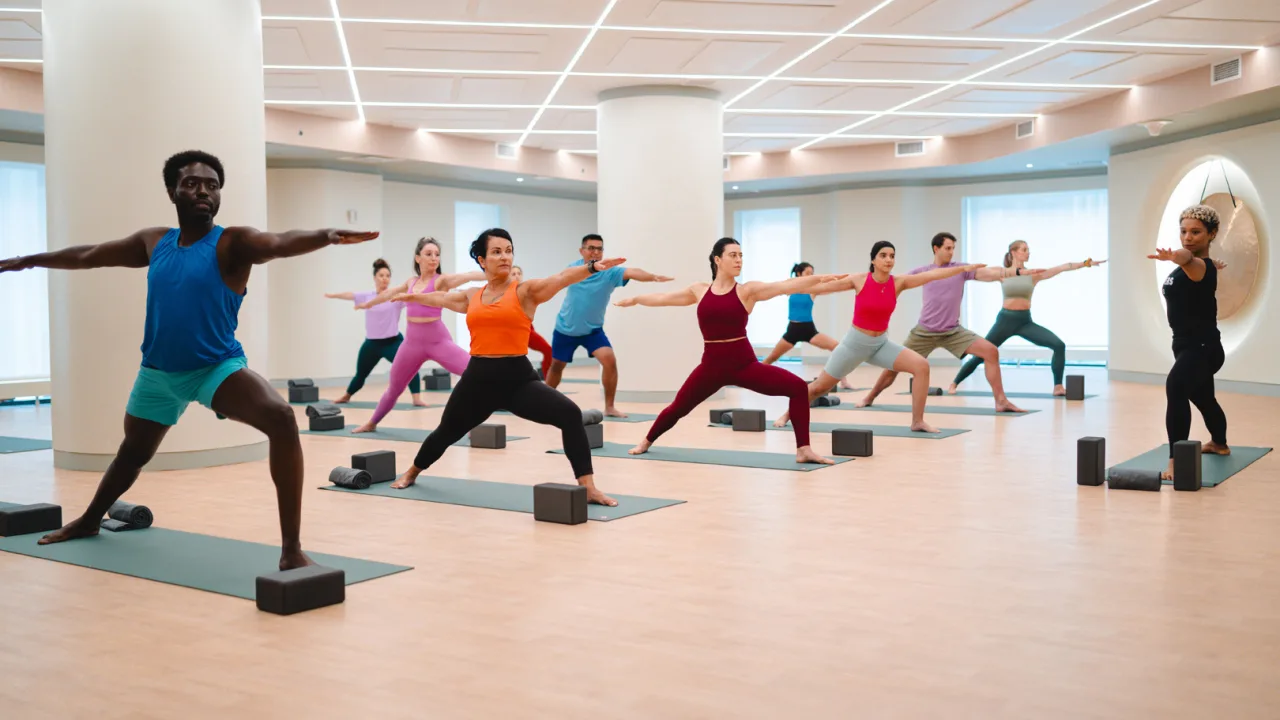How luxury gyms became the new third place
Four years ago, gyms were in trouble. It was the early days of the COVID pandemic, and the government implemented a temporary mandate to close fitness centers. People squeezed their workout routines into whatever shape they could take in basements, backyards, or the cramped corner of an apartment. As a result, a number of budget gyms declared bankruptcy in 2020, including Gold’s Gym, 24 Hour Fitness, and Town Sports International (the parent company of New York Sports Club). Just last month, Blink Fitness, a subsidiary of Equinox Holdings, was the latest of low-cost gyms to file for Chapter 11. On the other end of the spectrum, luxury gyms like Equinox, Life Time Fitness, and Chelsea Piers—where monthly memberships cost, at minimum $200 a month, though they can be much more—have expanded both their offerings and their square footage. [Photo: Chelsea Piers Fitness] Luxury fitness centers and budget gyms have faced disparate fate post-COVID. It’s leading to a higher-end fitness market where members expect their gyms to be more than a place to just exercise. “The Blinks and the Planet Fitnesses, people go in for 45 minutes or an hour, and they leave, and that’s it,” says David Tewksbury, cofounder of Chelsea Piers New York and CEO of Chelsea Piers Fitness. “We try to engage our members and be more than just a four walled space full of gym equipment.” [Photo: Chelsea Piers Fitness] Chelsea Piers Fitness, which opened its newest location in Manhattan’s Flatiron District last month, has operated in New York City since 1995. At the time, the gym’s original location (along the Hudson River’s piers in Chelsea, after which the fitness chain is aptly named), was the largest exercise complex in the city at about 130,000 square feet, according to Tewksbury. [Photo: Chelsea Piers Fitness] Tewksbury says he and his other cofounders, Roland Betts and Tom Bernstein, initially had no plans to expand the brand outside of the massive 475,000-square-foot sports complex they developed in Stamford, CT, in 2012. But in 2017, the team was approached by “a large New York City real estate developer” through a family friend, who proposed they take Chelsea Piers to Brooklyn. [Photo: Chelsea Piers Fitness] “If we [built a luxury gym] well, we would have a leg up on our competition. The only other company at that time in the sort of premium quality fitness space was Equinox,” Tewksbury says. Since then, the brand has been on a tear, opening locations in downtown Brooklyn, Prospect Heights in Brooklyn, and Manhattan’s Flatiron neighborhood. The next Chelsea Piers gym, located in Long Island City, Queens, is slated to open its doors in 2026. [Photo: Chelsea Piers Fitness] At the Flatiron location, members can enjoy luxuries including spacious locker rooms, a cold plunge pool, an infrared sauna, a coworking space, and a kids club. Fitness enthusiasts can choose between a wealth of classes on any given day, including cycling, pilates, boxing, barre, or yoga in the environment of their choice—either the Himalayan salt paneled room or the infrared studio. “We probably have the best collection of yoga facilities in New York City now. And group fitness is really where it’s at,” Tewksbury says. “That’s sort of one of the big differences with the Blinks and the Planet Fitnesses. We spend a ton of time and make a big investment in our group fitness program.” [Photo: Chelsea Piers Fitness] A community center with gym equipment But the brand also offers a number of community-based activities that have nothing to do with exercise. Recent member events include monthly book club sessions, a movie night, comedy shows and trivia, an African drumming workshop, a drag brunch in celebration of Pride Month, and a private beer tasting with Brooklyn-based brewery Talea Beer Co. “When we open clubs in new neighborhoods, we also like to establish relationships with existing businesses, whether they’re restaurants or wine stores or local boutique hotels, so that we have a network of other organizations that are sort of brand compatible with what we’re doing,” Tewksbury says. [Photo: Chelsea Piers Fitness] Tewksbury believes gyms can serve as a gathering place for local communities, and the events are a way to establish connections between members, amid the backdrop of a persistent loneliness epidemic. “It’s great to work [remotely]. But that means you might be alone in your apartment three or four days a week, just staring at your screen, doing Zoom calls, and you’re losing that human interaction,” Tewksbury says. “COVID really cemented our focus on activating our clubs with trying to enhance member engagement [and making] it easy for people to make friends and connect with other like-minded individuals.” [Photo: Chelsea Piers Fitness] The approach seems to be paying off for Chelsea Piers, which amassed 2,000 members at the Flatiron club within less than a month of opening—a number that T

Four years ago, gyms were in trouble. It was the early days of the COVID pandemic, and the government implemented a temporary mandate to close fitness centers. People squeezed their workout routines into whatever shape they could take in basements, backyards, or the cramped corner of an apartment.
As a result, a number of budget gyms declared bankruptcy in 2020, including Gold’s Gym, 24 Hour Fitness, and Town Sports International (the parent company of New York Sports Club). Just last month, Blink Fitness, a subsidiary of Equinox Holdings, was the latest of low-cost gyms to file for Chapter 11.
On the other end of the spectrum, luxury gyms like Equinox, Life Time Fitness, and Chelsea Piers—where monthly memberships cost, at minimum $200 a month, though they can be much more—have expanded both their offerings and their square footage.

Luxury fitness centers and budget gyms have faced disparate fate post-COVID. It’s leading to a higher-end fitness market where members expect their gyms to be more than a place to just exercise.
“The Blinks and the Planet Fitnesses, people go in for 45 minutes or an hour, and they leave, and that’s it,” says David Tewksbury, cofounder of Chelsea Piers New York and CEO of Chelsea Piers Fitness. “We try to engage our members and be more than just a four walled space full of gym equipment.”

Chelsea Piers Fitness, which opened its newest location in Manhattan’s Flatiron District last month, has operated in New York City since 1995. At the time, the gym’s original location (along the Hudson River’s piers in Chelsea, after which the fitness chain is aptly named), was the largest exercise complex in the city at about 130,000 square feet, according to Tewksbury.

Tewksbury says he and his other cofounders, Roland Betts and Tom Bernstein, initially had no plans to expand the brand outside of the massive 475,000-square-foot sports complex they developed in Stamford, CT, in 2012. But in 2017, the team was approached by “a large New York City real estate developer” through a family friend, who proposed they take Chelsea Piers to Brooklyn.

“If we [built a luxury gym] well, we would have a leg up on our competition. The only other company at that time in the sort of premium quality fitness space was Equinox,” Tewksbury says. Since then, the brand has been on a tear, opening locations in downtown Brooklyn, Prospect Heights in Brooklyn, and Manhattan’s Flatiron neighborhood. The next Chelsea Piers gym, located in Long Island City, Queens, is slated to open its doors in 2026.

At the Flatiron location, members can enjoy luxuries including spacious locker rooms, a cold plunge pool, an infrared sauna, a coworking space, and a kids club. Fitness enthusiasts can choose between a wealth of classes on any given day, including cycling, pilates, boxing, barre, or yoga in the environment of their choice—either the Himalayan salt paneled room or the infrared studio.
“We probably have the best collection of yoga facilities in New York City now. And group fitness is really where it’s at,” Tewksbury says. “That’s sort of one of the big differences with the Blinks and the Planet Fitnesses. We spend a ton of time and make a big investment in our group fitness program.”

A community center with gym equipment
But the brand also offers a number of community-based activities that have nothing to do with exercise. Recent member events include monthly book club sessions, a movie night, comedy shows and trivia, an African drumming workshop, a drag brunch in celebration of Pride Month, and a private beer tasting with Brooklyn-based brewery Talea Beer Co.
“When we open clubs in new neighborhoods, we also like to establish relationships with existing businesses, whether they’re restaurants or wine stores or local boutique hotels, so that we have a network of other organizations that are sort of brand compatible with what we’re doing,” Tewksbury says.

Tewksbury believes gyms can serve as a gathering place for local communities, and the events are a way to establish connections between members, amid the backdrop of a persistent loneliness epidemic.
“It’s great to work [remotely]. But that means you might be alone in your apartment three or four days a week, just staring at your screen, doing Zoom calls, and you’re losing that human interaction,” Tewksbury says. “COVID really cemented our focus on activating our clubs with trying to enhance member engagement [and making] it easy for people to make friends and connect with other like-minded individuals.”

The approach seems to be paying off for Chelsea Piers, which amassed 2,000 members at the Flatiron club within less than a month of opening—a number that Tewksbury reports as pacing ahead of sales for the two previous club openings in Brooklyn. Part of that, he says, is because people are yearning to find a third space that offers the amenities of an office or apartment, but functions distinctly as neither.
“When we opened the Downtown Brooklyn and the Prospect Heights locations over the past few years, the member lounges are used all the time, and some people are just relaxing, reading a book, but a lot of them are there with their laptop open, or using the phone booths to take calls,” Tewksbury says. “We’re not a WeWork, and we don’t want to be a WeWork. But we want to be a convenience to our membership.”






















